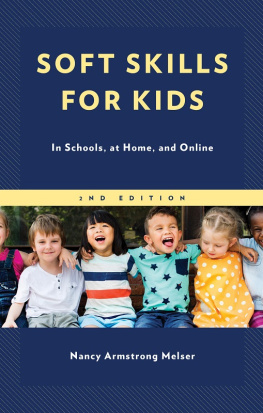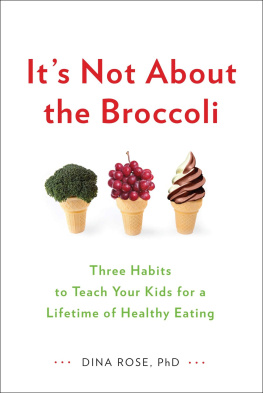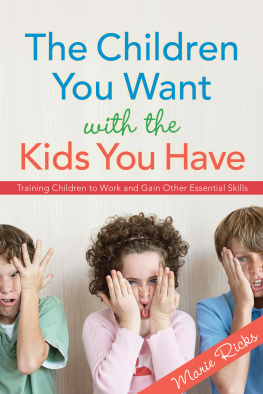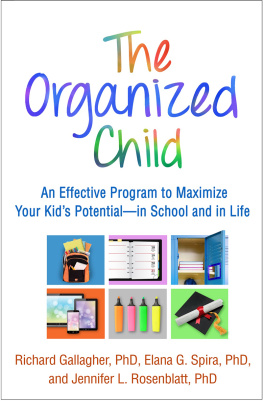Contents
Guide

The author and publisher have provided this e-book to you for your personal use only. You may not make this e-book publicly available in any way. Copyright infringement is against the law. If you believe the copy of this e-book you are reading infringes on the authors copyright, please notify the publisher at: us.macmillanusa.com/piracy.
Contents
Dedicated to the nine children
who will be judged by the things
their mothers wrote:
Bobette, Laura, Wesley,
Becky, and Madison McCullough;
Melea, Eric, Sarah, and Marc Monson.
ACKNOWLEDGMENT
Special thanks to Barbara Anderson, our editor at St. Martins Press; to our readers, David H. Monson and Glenna Hansen Berg; to our husbands, Robert McCullough and David H. Monson; and to our children for their support and encouragement.
Introduction
Today money is tight, time is rushed, and most of us feel we could use some help at home. But how many parents have tapped the closest potential resource, their children? Its a marvelous theory, we hear, however it takes more time than it saves. Parents might be able to do a task better and faster than their children, but should they? No. We think it is a good idea for our children to work at home because children need to learn to work and parents need their help.
By the time your children reach eighteen years of age, they will have spent 32,234 hours under your guidance and training. Consider that it takes only 2,100 hours of classroom and outside study time to complete a bachelors degree in college and half that time to learn some skilled trades. Your home has sixteen times more teaching hours than does the university. What do you want to do with this time?
Think about your children walking out the door, on their own! We assume they can cope with the everyday challenges of living, but should we? We assume they know about basic household duties and maintenance, but do they? We assume they can efficiently prepare well-balanced, nutritious meals, but can they? We assume they have mastered some basic skills of orderliness with their personal belongings, but have they? We assume they will handle their earnings wisely, avoiding unnecessary debt, but will they? Too often parents let the chips fall where they may, hoping all will turn out for the best. Can we leave the basic teachings to chance? Is there a better way?
This book was written to share principles, strategies, and tips on how to help your children succeed in home assignments. B. F. Skinner discovered, through his experiments with pigeons, that he could get a bird to peck ten thousand times in hopes of getting a food-pellet reward. Children can manipulate adults to get the attention or the reward they seek. Like the pigeon, they try over and over again to get the reward whether it be positive or negative. We will show you how to turn the negative responses into positive responses that motivate the child to do what you think he or she should do, which, in this case is work at home.
In this book youre going to learn what skills a child should know at what age. You will learn how to teach those skills, and you will learn how to motivate your child to perform them. It seems that someone else can usually get a child to work better than the parent can, but the parent can role-play or dramatize the situation to make it fun and create the outside incentive to get the child to work. Stories, charts, games and techniques are offered to keep the child working until he or she has the maturity and inner desire to do so.
If you are looking for a trick to bring about immediate results right now, try the guessing game. Have the child put away ten items in a room and you guess what has been put away. To change the drop-it habit of children who leave coats, books, and personal belongings all over the central living areas of the house, initiate the Eight oclock Pick-up as described ). Chapter twelve, titled 401 Ways to Get Your Child to Work at Home, offers many suggestions of tricks and principles to spark your creativity in getting your children to work in positive ways.
Other parts of this book, like Setting Goals, Knowing the Learning Seasons, or Getting Together, offer the theory behind establishing a strong family foundation to help rear responsibly independent children. This book will help focus attention on a workable plan for parents and children to follow in using those 32,234 teaching hours productively. It is intended as a guide to success in areas one might otherwise leave to happenstance. You may have to change some of your own actions and perhaps alter the physical set-up of the home environment to help the child improve.
It is not too late to start, no matter what the age of your child, although the methods and incentives may vary. Give yourself credit for what you have done. Your interest in this book shows you are already seeking to initiate some of these ideas. Leave behind any regrets for past mistakes. You have done the best you could with the tools you had at the time. We cannot promise that your children will take over the housework or even initiate any tasks on their own, but at least we can help you train them, so that when they do have their own homes, and the inner desire to keep them nice, they will have the skills to do so.
In a survey of 250 children, over ninety-seven percent honestly felt they should work at home. Lets teach them and give them the opportunity. Training children to work offers many rewards. For the children it adds greatly to their self-esteem and sense of belonging. They gain skills necessary for adult life, establish patterns of success that foster independence and self-reliance, and learn to work quickly and efficiently. There is a greater awareness of the value of things and more appreciation of efforts made by others. The parent is rewarded because part of the workload is lifted, the anger of feeling used is removed, and there is more time for the fun things of life. The parent feels a sense of success in preparing the child for the adult world, as the familiar phrase admonishes:
Catch me a fish and Ill eat today.
Teach me to fish and Ill eat the rest of my life.

1: Setting the Goals
When your children leave home to go out into the world on their own, what home skills will they be able to perform? If you could give each child fifty thousand dollars as he or she departs, would that be as valuable as if they had mastered some basic skills in preparation for adult life: The little things that have to be done every day even if they live to be 103? If young adults know how to clean a house and keep it that way, how to select and cook good food, or how to budget money, then they are released from the extra time it takes to learn these things when time is needed to concentrate on studies, career, or other areas of living.
Consider the case of a twenty-one-year-old girl named Annie who moved to Colorado hoping the dry climate would help clear up a health problem. When she drove up to her new apartment in her little compact car, she had her clothes and six thousand dollars worth of debts. Her own parents had advised her to buy not a used but a brand-new car, a new sewing machine (she is learning to sew), a new piano (someday she hopes to play), and correspondence art lessons; all of these when her job paid minimum wage. Annies lack of understanding of nutrition and how to cook soon affected her health. She struggled to read a city map. She had had so little experience in the world that it was easy for someone to take advantage of her. A friend called her from overseas, collect, and talked for twenty minutes. You guessed it! She did not know that collect meant she would pay for the call. All of these problems and a lack of preparation made her very discouraged. Is it possible that many of us are raising Annies?











